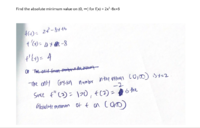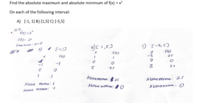You are using an out of date browser. It may not display this or other websites correctly.
You should upgrade or use an alternative browser.
You should upgrade or use an alternative browser.
Absolute Maxima and Minima
- Thread starter three3985
- Start date
Dr.Peterson
Elite Member
- Joined
- Nov 12, 2017
- Messages
- 16,093
You're right on the first problem. The absolute minimum is -2, at x=2.
For the second, check for sign errors! And is 0 in [1, 5]? Sketching a graph might help prevent those errors.
For the second, check for sign errors! And is 0 in [1, 5]? Sketching a graph might help prevent those errors.
You're right on the first problem. The absolute minimum is -2, at x=2.
For the second, check for sign errors! And is 0 in [1, 5]? Sketching a graph might help prevent those errors.
Just realised I've made some error. So to clarify, the absolute minimum for A is 0 whilst the absolute minimum for B is 1?
On your first one, your answer of x = 2 is correct, however, your analysis has an error. You write that f ''(2) = 1, but f '' (x) is the horizontal line y = 4.
Hey, thanks for replying, I wrote f ''(2) = 1>0, f (2) = -2 would be the absolute minimum, is that incorrect?
Dr.Peterson
Elite Member
- Joined
- Nov 12, 2017
- Messages
- 16,093
You meant maximum there, right?Just realised I've made some error. So to clarify, the absolute minimum for A is 0 whilst the absolute minimum for B is 1?
You had previously written, f"(x) = 4, so clearly f"(2) = 4, not 1, right? Where did you get 1?Hey, thanks for replying, I wrote f ''(2) = 1>0, f (2) = -2 would be the absolute minimum, is that incorrect?
You meant maximum there, right?
You had previously written, f"(x) = 4, so clearly f"(2) = 4, not 1, right? Where did you get 1?
1) Isn't the maximum 25 and the minimum 1 for B?
2) Oh thanks for spotting that out for me, I really appreciate it.
Last edited:
Dr.Peterson
Elite Member
- Joined
- Nov 12, 2017
- Messages
- 16,093
I misread what you wrote, thinking "the absolute minimum for A is 0 whilst the absolute minimum for B is 1" was all about A (the minimum and maximum). I missed "for B".1) Isn't the maximum 25 and the minimum 1 for B?
HallsofIvy
Elite Member
- Joined
- Jan 27, 2012
- Messages
- 7,763
Personally, on neither of those would I take the derivative. Instead, complete the square!
$2x^2- 8x+ 6= 2(x^2- 4x)+ 6= 2(x^2- 4x+ 4- 4)+ 6= 2(x- 2)^2- 8$.
Since a square is never the minimum is -8 when x= 2. We also need to check the endpoint x= 0. $2(0^2)- 8(0)= 6= 6$ and as x goes to infinity, the value increases indefinitely.
The absolute minimum is -8 and there is no absolute maximum.
$x^2$ is already a perfect square. Its minimum is 0 at x= 0. Then we need to check the endpoints of the intervals.
A. [-1, 1] $(-1)^2= 1$, and $1^2= 1$, The interval includes x= 0 so the minimum is 0 and the maximum is 1.
B. [1, 5] $1^2= 1$ and $5^2= 25$. The minimum is 1 and the maximum is 25.
C. [-5, 5] $(-5)^2= 26$ and $5^2= 25$. The interval includes 0 so the minimum is 0 and the maximum is 25.
$2x^2- 8x+ 6= 2(x^2- 4x)+ 6= 2(x^2- 4x+ 4- 4)+ 6= 2(x- 2)^2- 8$.
Since a square is never the minimum is -8 when x= 2. We also need to check the endpoint x= 0. $2(0^2)- 8(0)= 6= 6$ and as x goes to infinity, the value increases indefinitely.
The absolute minimum is -8 and there is no absolute maximum.
$x^2$ is already a perfect square. Its minimum is 0 at x= 0. Then we need to check the endpoints of the intervals.
A. [-1, 1] $(-1)^2= 1$, and $1^2= 1$, The interval includes x= 0 so the minimum is 0 and the maximum is 1.
B. [1, 5] $1^2= 1$ and $5^2= 25$. The minimum is 1 and the maximum is 25.
C. [-5, 5] $(-5)^2= 26$ and $5^2= 25$. The interval includes 0 so the minimum is 0 and the maximum is 25.


